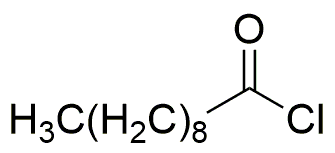Decanoyl chloride is widely utilized in research focused on:
- Synthesis of Esters: It serves as a key reagent in the production of esters, which are important in the flavor and fragrance industry. For example, it can be used to create fruity scents in perfumes.
- Pharmaceutical Intermediates: This compound is crucial in synthesizing various pharmaceutical agents, enhancing drug formulations, and improving bioavailability. Its ability to modify molecular structures makes it valuable in drug development.
- Polymer Production: Decanoyl chloride is used in the manufacture of polyamides and other polymers, which are essential in creating durable materials for textiles and automotive applications.
- Surface Coatings: It is employed in the formulation of surface coatings and adhesives, providing enhanced adhesion properties and chemical resistance, beneficial in construction and manufacturing sectors.
- Research Applications: In academic and industrial laboratories, it is used for chemical research and development, particularly in studying reaction mechanisms and developing new synthetic pathways.
General Information
Properties
Safety and Regulations
Applications
Decanoyl chloride is widely utilized in research focused on:
- Synthesis of Esters: It serves as a key reagent in the production of esters, which are important in the flavor and fragrance industry. For example, it can be used to create fruity scents in perfumes.
- Pharmaceutical Intermediates: This compound is crucial in synthesizing various pharmaceutical agents, enhancing drug formulations, and improving bioavailability. Its ability to modify molecular structures makes it valuable in drug development.
- Polymer Production: Decanoyl chloride is used in the manufacture of polyamides and other polymers, which are essential in creating durable materials for textiles and automotive applications.
- Surface Coatings: It is employed in the formulation of surface coatings and adhesives, providing enhanced adhesion properties and chemical resistance, beneficial in construction and manufacturing sectors.
- Research Applications: In academic and industrial laboratories, it is used for chemical research and development, particularly in studying reaction mechanisms and developing new synthetic pathways.
Documents
Safety Data Sheets (SDS)
The SDS provides comprehensive safety information on handling, storage, and disposal of the product.
Product Specification (PS)
The PS provides a comprehensive breakdown of the product’s properties, including chemical composition, physical state, purity, and storage requirements. It also details acceptable quality ranges and the product's intended applications.
Certificates of Analysis (COA)
Search for Certificates of Analysis (COA) by entering the products Lot Number. Lot and Batch Numbers can be found on a product’s label following the words ‘Lot’ or ‘Batch’.
*Catalog Number
*Lot Number
Certificates Of Origin (COO)
This COO confirms the country where the product was manufactured, and also details the materials and components used in it and whether it is derived from natural, synthetic, or other specific sources. This certificate may be required for customs, trade, and regulatory compliance.
*Catalog Number
*Lot Number
Safety Data Sheets (SDS)
The SDS provides comprehensive safety information on handling, storage, and disposal of the product.
DownloadProduct Specification (PS)
The PS provides a comprehensive breakdown of the product’s properties, including chemical composition, physical state, purity, and storage requirements. It also details acceptable quality ranges and the product's intended applications.
DownloadCertificates of Analysis (COA)
Search for Certificates of Analysis (COA) by entering the products Lot Number. Lot and Batch Numbers can be found on a product’s label following the words ‘Lot’ or ‘Batch’.
*Catalog Number
*Lot Number
Certificates Of Origin (COO)
This COO confirms the country where the product was manufactured, and also details the materials and components used in it and whether it is derived from natural, synthetic, or other specific sources. This certificate may be required for customs, trade, and regulatory compliance.


